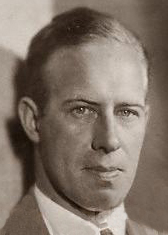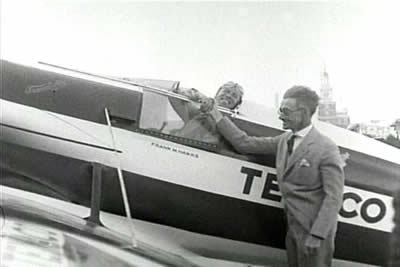|
Frank
Hawks

Frank Hawks (1897-1938) circa 1930
Frank Hawks was one of the
aviation legends of the golden era of flight. He set speed
records and demonstrated new techniques. Through his
association with Texaco, he also contributed to the
commercialization of aviation
1917
Once a flight instructor at Love Field in 1917 and a captain
in the fledgling Air Service, after the Great War, he made
his living as a barnstorming pilot, and demonstrated the
first in-flight refueling as early as 1921.
1927
In 1927, the Texas Oil Company (Texaco) organized its own
Aviation Department to market aviation products. The
division soon ordered its first plane, "Texaco One", a
custom built Ford Trimotor (NC3443), delivered in February,
1928. Texaco hired Frank Hawks to advertise the company
across the country. He embarked on the tour which he
described, in his autobiography "Speed", "In the course [of
the tour]. I visited 175 cities, carried 7,200 passengers,
and did 56,000 miles of cross-country flying. All of this
without a mishap to plane and passengers."
The Trimotor was destroyed in a crash at Floresville,
Florida, in December, 1928. Texaco bought a Lockheed Vega,
known as "Texaco Five." In February 1929, Hawks flew it from
the Burbank factory to New York in 18 hours 22 minutes, a
new transcontinental record. Four month later, Hawks and
Texaco Five bested their own record by 43 minutes. It flew
some 90,000 miles before being lost in a January 1930
accident in West Palm Beach, Florida.
1929
Captain Hawks in 1929 established a record roundtrip flight
between New York and California. in 1929 he set a
transcontinental speed record of 18 hours and 21 minutes...
1930 - The Glider Flight
He made the first transcontinental glider flight in 1930. he
also piloted a towed glider for 2860 miles across the US...
Frank Hawks had recently become interested in gliding when
he saw a Franklin glider, "9491," perform at the Detroit
Glider Carnival in 1929. When "9491" was still impressing
crowds around the country, its designers, R.E. and Wallace
Franklin, had begun building an improved model. They offered
it to Hawks, who oversaw its completion. Hawks' employer,
Texaco, endorsed Hawks' gliding activities because they
thought the sport would attract people to aviation. Company
officials believed that glider pilots would eventually move
to flying powered aircraft fueled and oiled by Texas Company
products. Hawks purchased the glider using company funds.
Before the new Franklin glider was completed, Hawks and
Texaco had devised a spectacular stunt to stoke public
interest in both motorless and powered flight. Hawks planned
to fly the glider coast to coast, in tow behind a Waco Ten
biplane. During the flight, the glider would land
frequently, and at every airfield, Hawks would meet with
reporters.
Construction of the new glider. The fuselage was framed by
three steel tubes, welded and riveted at both ends. A brake
was added to the main wheel. The wings were of
fabric-covered wood, both removable for transport. The basic
instrument panel consisted of an airspeed indicator,
altimeter, and slip/skid indicator. The completely enclosed
cockpit included a radio and a telephone. A stylized eagle
and the Texaco logos decorated the craft. Hawks christened
it the "Eaglet" but it was renamed the "Texaco Eaglet" after
the transcontinental flight. The glider's maximum speed was
125 mph, and flight tests pegged the stall speed at 15 mph.
Total cost of the "Texaco Eaglet" came to $2,500.
A 500 ft tow rope was selected and carefully tested to be
just strong enough, so that it would break before the wings
of the "Texaco Eaglet" or the Waco Ten tow plane. Both
aircraft could release the rope in an emergency.
Piloting the glider, Hawks took off from San Diego's
Lindbergh Field on March 30, 1930. A Waco Ten biplane,
"Texaco No. 7," powered by a 220 hp Wright J-5 engine, and
piloted by J. D. "Duke" Jernigin, Jr., towed Hawks' glider.
Jernigin carried one passenger, Wallace Franklin. They
stopped daily for fuel, following the same routine. Hawks
released the tow rope when over the airfield, and performed
a short air show for the crowd below. Meanwhile the Waco Ten
landed and refueled. and waited to hook-up to the "Texaco
Eaglet" and takeoff on the next leg. This routine kept
ground time to a minimum, allowing them to keep to their
aggressive schedule and meet the large crowds (5,000 -
10,000 people) at the next stop.
Their itinerary included Yuma (Arizona), Phoenix, Tucson, El
Paso, Midland, Wichita Falls, Oklahoma City, Tulsa,
Springfield (Misouri), East St. Louis, Terre Haute,
Indianapolis, Columbus (Ohio), Cleveland, Buffalo, Syracuse,
and Albany. The flight ended at Van Cortlandt Park in New
York City on April 6. They broke a coouple tow ropes, but
otherwise made good time.
During the eight day flight, the pilots logged 44 hours of
air time and covered 2,860 miles. They carried twelve pounds
of "glider" mail and a palm tree seedling from the city of
Los Angeles to the citizens of New York. After a few more
flights, they donated the airplanes to the Smithsonian.
1930 - The Travelair Mystery Ship

Frank Hawks (1897-1938) piloting the Travel Air Mystery
Ship, NR-1313; and Bill Stout of the Stout Metal Aircraft
Company
In the late 1920's the
Travelair company built a few "Mystery Ships," racing
airplanes whose details of construction were closely guarded
secrets. In 1930, Texaco bought the fourth "Mystery Ship"
from the Travel Air company, for Hawks to fly in the
National Air Races.
"Texaco 13" was identical to the other "Mystery Ships", but
included a cockpit full of special instruments for long
distance flights, so the ship was heavier than the other
three. The cockpit was fully enclosed and almost flush with
the top of the fuselage. The racer was painted a Stearman
vermilion and white, with a blue stripe separating the red
and white. On two occasions he cracked the ship up, one time
injuring himself very, seriously. He never did well at the
Nationals as his plane was not set up for pylon type racing.
However, he raced at the 1930 National Air Races, his
"Texaco 13" wearing their Texaco shorter racing wings - race
No. 28. This wing switch was made at the factory prior to
the races. Hawks entered the Thompson Trophy Race but pulled
out of the race on the third lap. A piece of masking tape
placed over the gas cap (for streamlining) caused a loss of
pressure and the engine would not operate at full throttle.
Even so the "Texaco 13", with Frank Hawks at the controls,
did set many long distance records both in the United States
and in Europe. then beat his own speed record flying the
legenday Travel Air mystery ship Texico No. 13 which now
hangs in Chicago's Museum of Science.
He published Speed, his 314 page autobiography, in 1931.
1932

Frank Hawks (1897-1938) in 1932 next to NR12265, with the
Texaco Sky Chief logo
Frank Hawks to Amelia Earhart.
June 18, 1932. Congratulatory telegram."When you made your
marvelous flight I was a pretty sick hombre in Boston and
though belated my congratulations are, none the less
sincere. Am being honored to be among first to greet you on
your arrival . We are all very proud of you."
One of the first products of the new Northrop Corporation
was the Gamma special-purpose and mail-carrying aircraft.
The first two examples built were known as the Gamma 2A and
Gamma 2B. The Gamma 2A was built for the well known pilot
Frank Hawks and the Gamma 2B was built for the Lincoln
Ellsworth Trans-Antarctic Expedition. Each plane had an
enclosed cockpit set on top of the fuselage aft of the
wings. The two planes were completed in August of 1932. The
Gamma 2A was purchased by Texaco on December 6, 1932 and was
put at the disposal of Frank Hawks for record-breaking and
advertising purposes. It was given the civilian registration
NR12265, and flew with the Texaco Sky Chief logo prominently
displayed.
1933
On June 2, 1933, Hawks set a west-east nonstop record in his
Northrop Gamma, flying from Los Angeles to Floyd Bennett
Field, Brooklyn, N.Y. in 13 hours, 26 minutes and 15
seconds, at an average speed of 181 mph.
Commercial Endorsements
He didn't limit his commcerial endorsements to Texaco. You
can still find "FRANK HAWKS "AIR HAWKS" CLUB PIN 1930'S" on
Ebay. A cereal box prize for budding aimen of the the
1930's...(many members went on to become WW11 combat
pilots)...1 1/2 inch span gold metal wings with likeness of
famed pilot Frank Hawks in helmet and goggles with legend,
"FRANK HAWKS AIR HAWKS" and "Post Bran Flakes"..."It's not
too late to join!"....
Hawks was killed in 1938 flying a Gwinn Aircar that many
aviation experts considered a far safer aircraft than those
that he normally flew.

Lima News, Lima, Ohio, August 24, 1938
|
